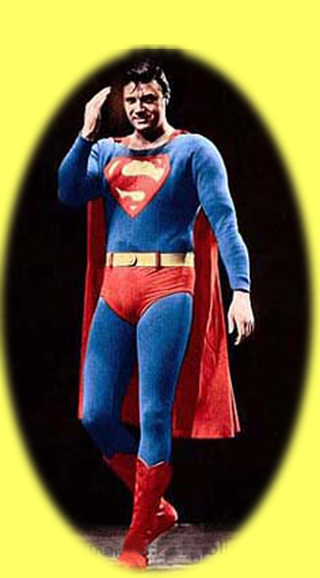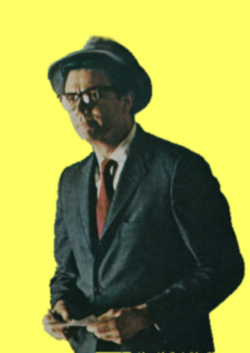

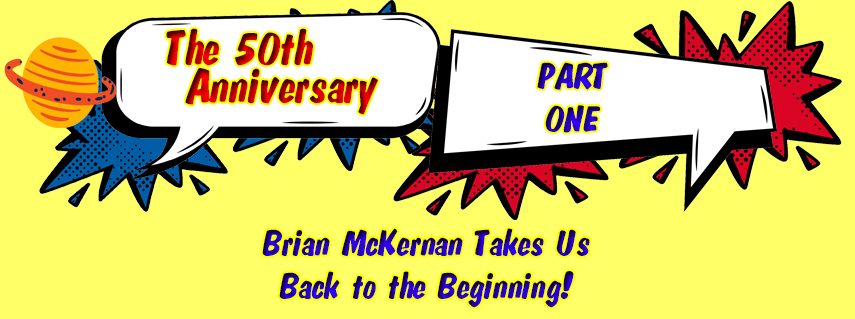
The year 2016 marked the 50th anniversary of the opening of "It's a Bird It's a Plane It's Superman©." Brian McKernan commemorated the event with a terrific retrospective on how this historic show hit Broadway.
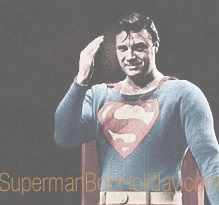 On the evening of Tuesday, March 29, 1966 a tall, handsome 33-year-old actor named Bob Holiday literally flew onto the stage of
New York’s Alvin Theatre dressed in a blue bodysuit and flowing red cape recognizable (then and now) to practically everyone on Earth.
The occasion was the premiere of "It's a Bird It's a Plane It's Superman©" a new musical from
acclaimed producer/director Hal Prince,
Bye-Bye Birdie composer Charles Strouse and lyricist Lee Adams, and up-and-coming librettists
David Newman and Robert Benton. In addition to Holiday, the show’s cast included Broadway favorites Jack Cassidy and Patricia Marand,
future Alice sitcom star Linda Lavin, and a zany young actor named Michael O’Sullivan.
On the evening of Tuesday, March 29, 1966 a tall, handsome 33-year-old actor named Bob Holiday literally flew onto the stage of
New York’s Alvin Theatre dressed in a blue bodysuit and flowing red cape recognizable (then and now) to practically everyone on Earth.
The occasion was the premiere of "It's a Bird It's a Plane It's Superman©" a new musical from
acclaimed producer/director Hal Prince,
Bye-Bye Birdie composer Charles Strouse and lyricist Lee Adams, and up-and-coming librettists
David Newman and Robert Benton. In addition to Holiday, the show’s cast included Broadway favorites Jack Cassidy and Patricia Marand,
future Alice sitcom star Linda Lavin, and a zany young actor named Michael O’Sullivan.
Critics praised "It's a Bird It's a Plane It's Superman©" Stanley Kauffmann of The New York Times said it was “The best musical so far this season,” adding, “it would be enjoyable in any season.” The show was nominated for three Tony Awards (for Cassidy, Marand, and O’Sullivan), and extra matinee performances were added to the show’s schedule. Nevertheless, the show closed on July 17 after just 129 performances. Benton attributed the short run to “capelash” caused by the immense popularity of the Batman TV series, which had premiered just two months earlier. Although matinee performances of "It's a Bird It's a Plane It's Superman©" were packed with youngsters, evening attendance steadily dwindled as adults assumed the show was just more of the same type of “camp” humor they could see for free at home on Batman.
Now, 50 years later, the lasting legacy of "It's a Bird It's a Plane It's Superman©"
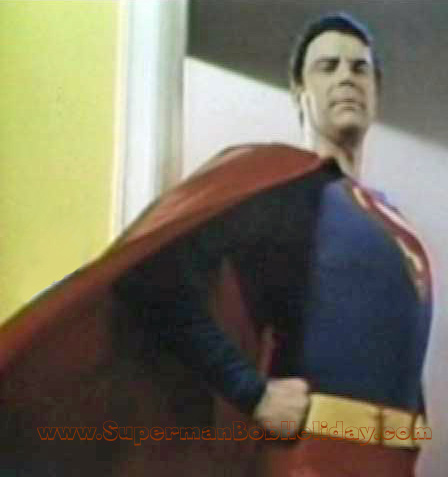 and its star
Bob Holiday can be better appreciated. In the intervening years the show has deservedly earned major respect among fans of the musical
theater, pop culture, and Superman. It has long been a popular choice for revivals large and small ever since the summer of 1967
when it was produced as a series of open-air nighttime performances in St. Louis and Kansas City. On the evening of July 4 Bob Holiday
reprised his Superman role and “flew” over 100 feet above the stage of the St. Louis Municipal Opera suspended from a construction
crane to the delight of an audience of more than 10,000. "It's a Bird It's a Plane It's Superman©"
was made into an ABC-TV special in 1975. Recent revivals have included Los Angeles in 2007, New York in 2013, and London in 2015.
Its original Columbia Records 1966 cast album has never been out of print.
and its star
Bob Holiday can be better appreciated. In the intervening years the show has deservedly earned major respect among fans of the musical
theater, pop culture, and Superman. It has long been a popular choice for revivals large and small ever since the summer of 1967
when it was produced as a series of open-air nighttime performances in St. Louis and Kansas City. On the evening of July 4 Bob Holiday
reprised his Superman role and “flew” over 100 feet above the stage of the St. Louis Municipal Opera suspended from a construction
crane to the delight of an audience of more than 10,000. "It's a Bird It's a Plane It's Superman©"
was made into an ABC-TV special in 1975. Recent revivals have included Los Angeles in 2007, New York in 2013, and London in 2015.
Its original Columbia Records 1966 cast album has never been out of print.
To put "It's a Bird It's a Plane It's Superman©" (the first-ever superhero stage production)
into its proper historical context, start with the fact that writer Jerry Siegel and artist Joe Shuster’s brilliant creation was
an instant hit when he debuted in the June 1938 issue of Action comics. During the next 28 years,
Superman’s savvy owners at National (DC) Comics carefully managed his career for additional success in a McClure newspaper strip, a
Mutual radio series, seventeen Paramount Technicolor theatrical cartoons,
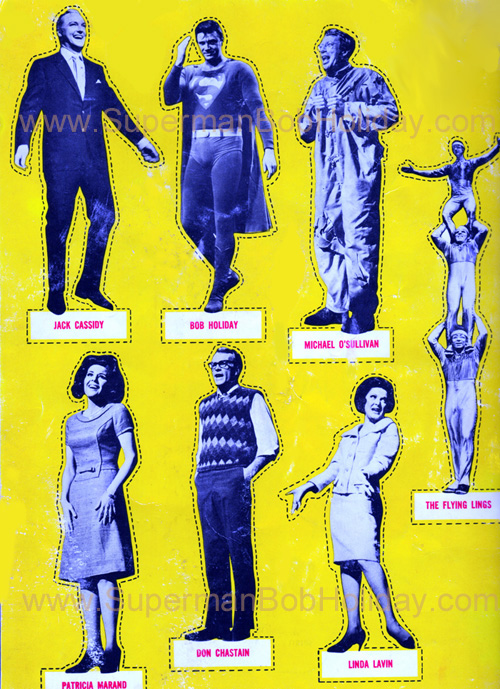 a Random House novel, two Columbia movie serials, a feature film, and a syndicated television series,which—by 1965—would rank as
the most profitable ever produced. Superman was an American original, like Mickey Mouse or Tarzan, and became so ingrained in
popular culture that even the noted academic Marshall McLuhan weighed in on analyzing the significance of the character.
a Random House novel, two Columbia movie serials, a feature film, and a syndicated television series,which—by 1965—would rank as
the most profitable ever produced. Superman was an American original, like Mickey Mouse or Tarzan, and became so ingrained in
popular culture that even the noted academic Marshall McLuhan weighed in on analyzing the significance of the character.
Given Superman’s long-term media saturation it’s not surprising that in 1965 the young creative team of Esquire magazine writers David Newman and Robert Benton saw the character as excellent subject matter for a Broadway musical. Comic strip characters had inspired New York stage productions at least as far back as 1903 (The Katzenjammer Kids), but what really helped Superman land on Broadway was the “Pop-Art” craze of the mid-1960’s. Composed of equal parts nostalgia and the incipient social rebellion that grew as the decade progressed, Pop-Art was described in an April 25, 1966 cover story in Newsweek magazine as “anything that is imaginative, nonserious, rebellious, new, or nostalgic; anything basically fun. [It’s] what’s happening.” Major practitioners of the form included Roy Lichtenstein and Andy Warhol, both of whom used reproductions of Superman comic-book panels in their work.
As Prince, Newman, Benton, Strouse, and Adams, and their colleagues worked to shape their Superman musical for Broadway they also faced the challenge of finding the right actor to fill the title role. After auditioning more than 50 hopefuls, they found their Superman in Bob Holiday, a six-foot, four-inch Army veteran and Brooklyn native who had performed on Broadway in the 1959 musical Fiorello! Bob recalled how he found out about the show in his 2003 book Superman on Broadway (co-written with Chuck Harter):
“After Lady in the Dark closed, around August of 1965, I returned to club gigs, commercials and MC work,” Bob stated. “To an actor, the most important thing is the work. At some point, I heard something about Hal Prince developing a new Broadway show. I knew Hal from my days in Fiorello! so I called his casting director to find out what was going on. She knew me, and told me that Hal was indeed casting a new musical. I asked what it was about, but she wouldn’t tell me. She did say that auditions were going to be held soon, and she would give me a call. It didn’t seem that important at the time.”
A few days later Bob read a newspaper article that Prince was looking for an actor to play Superman in a new musical.
“I got chills,” Holiday recalled. “I said, ‘Oh, my God...I’ve got to audition!’ Superman was my hero, and this was the chance of a lifetime. I called [the casting director] and found when the auditions were being held. The songs I chose to do for the audition were ... from Camelot. I kept thinking that this whole thing was weird. I am a Superman fan. I’ve seen Superman. If I want to be Superman, I have to do my best and completely believe in him. I thought a lot about him, and went out to buy a copy of Jules Feiffer’s book The Great Comic Book Heroes. It was very inspiring, and I was very ‘up’ for the audition.
“At the first [audition] I was left with about ten other guys. I sang the two tunes and left. I was working out on a regular basis at that time at the gym. For the next two days, I put in a lot of hours, and kept believing I had a shot. The call came back in and I went down, sang the two numbers again, and had a little bit of dialogue. About a week later, I got a second callback. It was now down to one other guy and me. I had a gut feeling that I’d get the part, because I was a genuine Superman fan.
“At the end of the audition they dismissed the other guy and told me I had the part. Hal Prince said he was very happy for me, and that this show was going to be a big hit. A chill went through me. I said, ‘Thank you. Thank you.’ ”
The rest, of course, is history. Composer Strouse noted years later that the tone of the show may have been hard for 1966 audiences to understand: campy, but not as campy as the Batman TV series, and comical, but in a way that may have been too subtle for the times. Nevertheless, Bob and his fellow cast members received great reviews, although in Bob’s case he had to portray not one, but two characters: Superman and his secret identity, the mild-mannered reporter (and quick-change artist) Clark Kent. Noting this, Hollywood Reporter critic Leonard Hoffman wrote: “Bob Holiday soars with the greatest of ease, and really wins his letter ‘S’ in the dual role of Superman and the staid, earthbound Clark Kent.”
Click Here for Part TWO!
